Liberty/Harber/Cooper State Centre Older Theaters
Metropolitan/Palace Folly Dreamland/Capitol Empress Majestic Rialto
Others Ads In The 1920s Ads In July 1943 Bricktown Harkins
Unless otherwise stated, you can click on the pics below for larger images – they will open in a separate window.
Before urban shopping centers and before the Pei Plan, downtown Oklahoma City was the center of shopping ... and, of course, the movies! If you'd want to see 2001: A Space Odyssey, that's where you'd go – downtown, and, in this instance, the Cooper Cinerama (immediately north of the Colcord Hotel).
So, step back about 30-35 years and even further back in time while you still could, and let's go downtown to the movies! OK! But, where to go?
The Overholser Opera House/Orpheum/Warner. Originally the 1903 Overholser Opera House at 217 W. Grand (Sheridan), notables such as Sarah Bernhardt and Lillian Russell performed there.
The Overholser Opera House (1903)
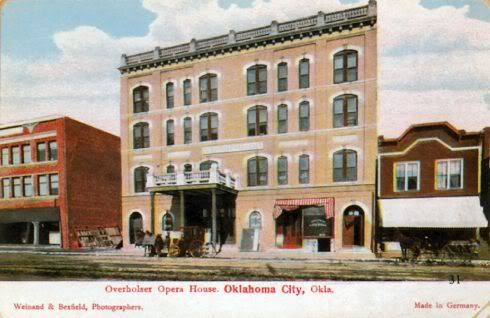
Around 1911, to the West (left) of the Colcord
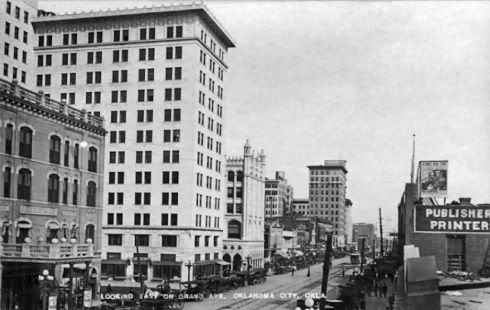
From Vanished Splendor II
A 1921 Renovation Made It the Orpheum
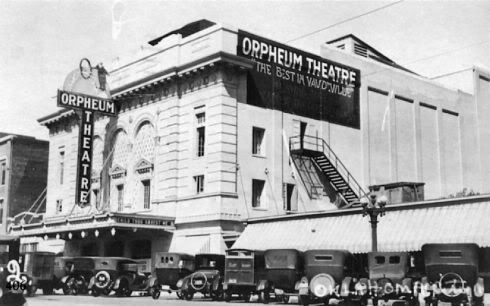
From Historic Photos of Oklahoma City, around 1925
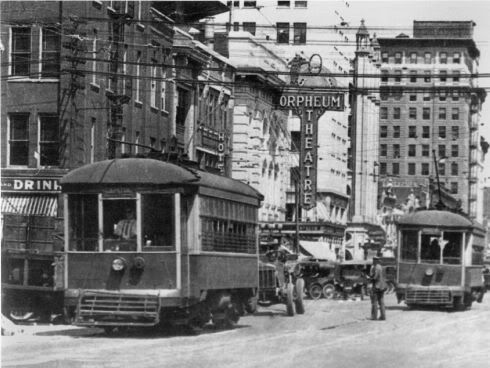
In 1928, being aquired by Warner Brothers, it became the Warner. In the mid-1950s, Warner Bros. renovated the building to become Oklahoma City's first Cinerama theater, as show in the pic from http://cinerama.topcities.com/warnerok.htm), below. Internet sources vary as to when this was done – compare http://cinerama.topcities.com/warnerok.htm with http://cinematreasures.org/theater/12888/ ... Cactus Jack's remarks).

The original seating is reported to have been about 2,400 ... the Warner Brothers changeover (with wider seats) dropped it to about 2,000 and the Cinerama make-over reduced it more. Sad to say, it was not my privilege to have set foot in this, the granddaddy of downtown movie houses. Below, it is shown featuring the 1956 Lowell Thomas' Seven Wonders of the World Cinerama production. The theater closed in 1964 and today it is part of the Center City Parking garage and lot.

The Criterion. The Criterion, designed by Boller Brothers and featuring a French style lobby and auditorium with an art deco mezzanine, was operated by the Paramount/Publix Theatre Circuit. Built in 1921 at 118 W. Main, it originally seated 1,900 but later remodelings reduced its size to 1,650. It was destroyed in 1973. For some nice interior and exterior pics, see Jeff Chapman's CinemaTour Criterion Page. Several other images appear below.

From the Okc Metropolitan Library System in 1928

From Oklahoma City: 2nd Time Around (next 2 pics)
The date is not stated but I'm guessing in the 1930s
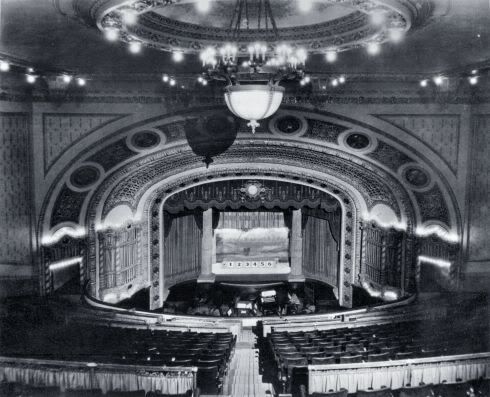
A cropped view of the same image
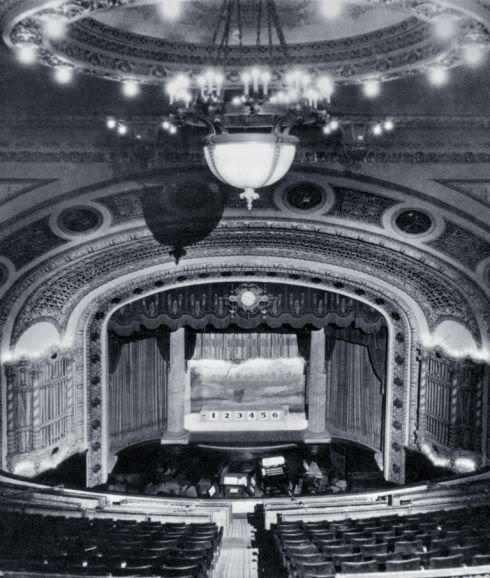
From Historic Photos of Oklahoma City in 1945
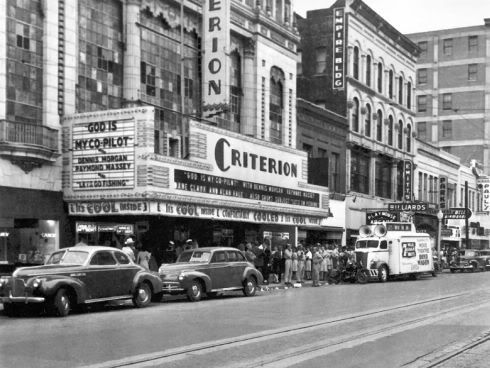
From Vanished Splendor II in 1949

Here's a pic from 1950 (click on the pic for a larger cropped view)
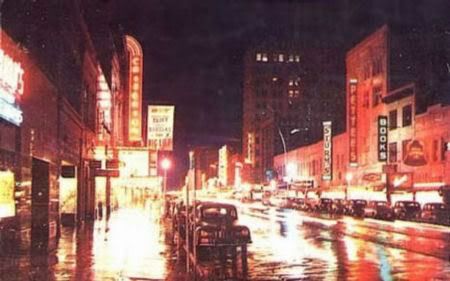
On February 17, 1953, Marilyn Monroe in Niagara
From my photograph collection (next 2 pics)
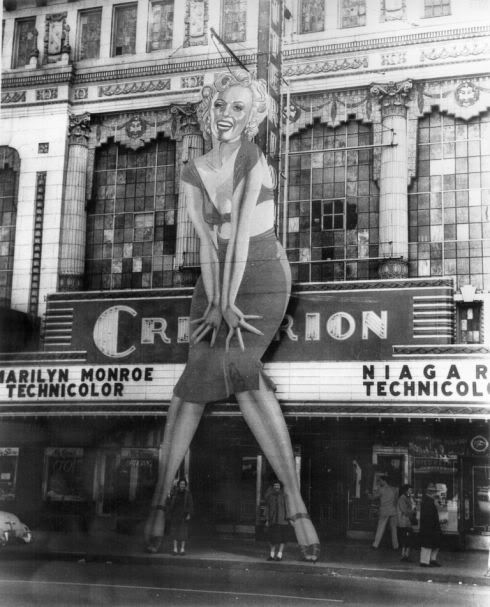
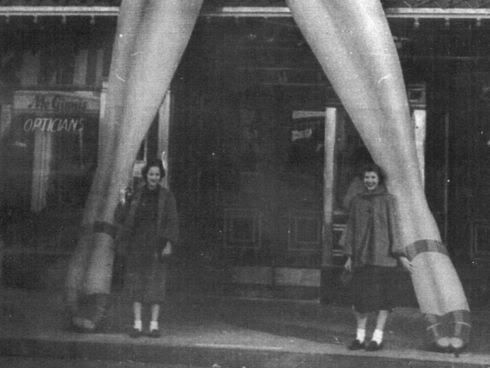
The Midwest. Ahhh ... visiting Oklahoma City in the mid-to-late 1950's as a teenager, my favorite was the Midwest, 16 N. Harvey, with its multiple balconies ... 5, I think, but certainly at least 4 (note: I've not been able to confirm the comment by John (that the Midwest had only one balcony) in the Comments, below, but I can't say that he is wrong, either, even if my childhood memory is different). Like the Warner, the Midwest was owned by Warner Brothers. It opened in 1930, seating capacity was around 1,600 - 1,700, and closed in 1975.
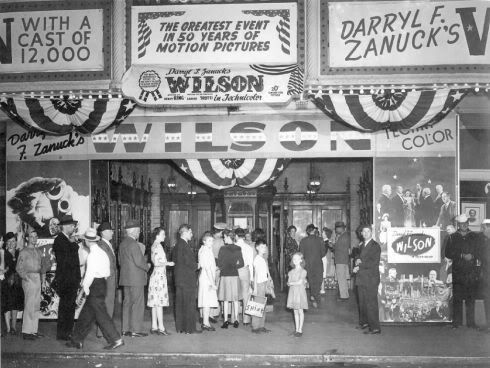
1947's World Premier of "Black Gold", Anthony Quinn in the middle
It's about the Oklahoma horse that won the Kentucky Derby
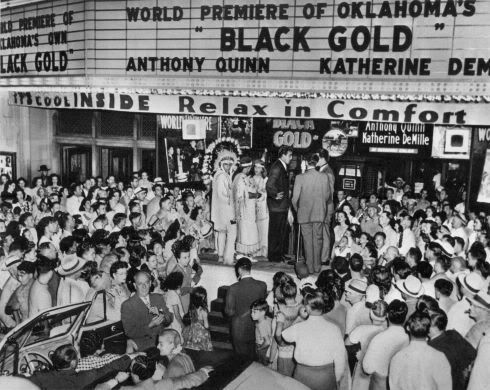
A cropped view showing Anthony Quinn
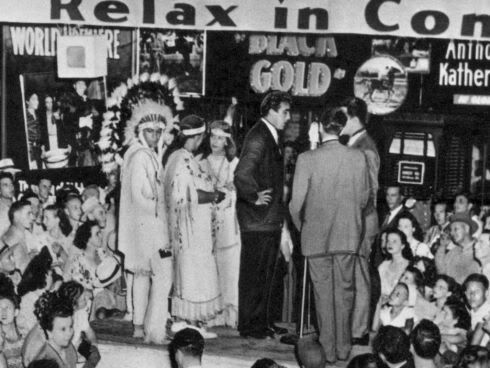
From Jeff Chapman's CinemaTour Midwest Page
Click the above link for many nice images, inside and out
The Midwest in 1970
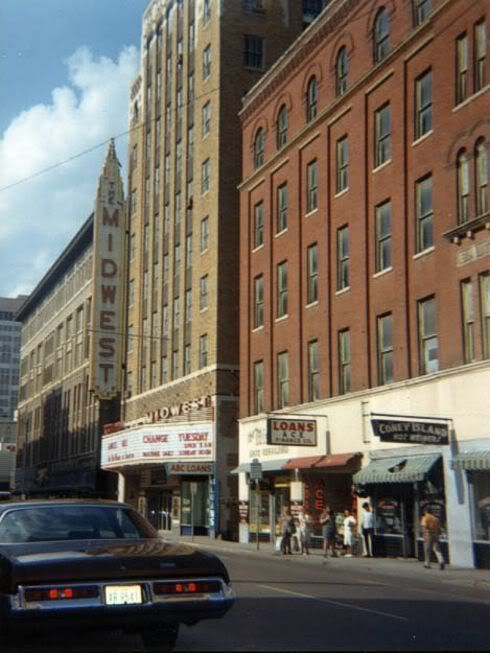
From Oklahoma County: Heart of the Promised Land (next 3 pics)
Auditorium Views, Probably during the 1920s-1930s (new scans 10/22/2007)

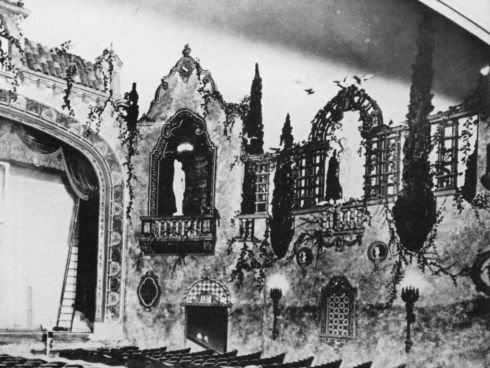
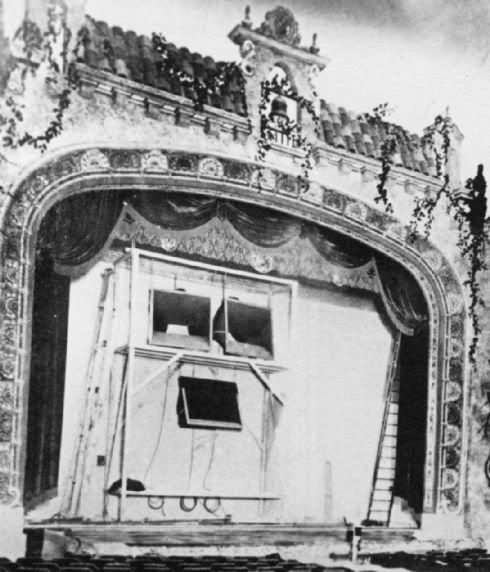
Some Preserved Lighting Fixtures
Norman Thompson kindly supplied these images to me.
His mom purchased the fixtures from the Midwest before it was demolished.
The 1st image shows a fixture from the theater's mezzanine
but I'm not sure where the 2nd was located.

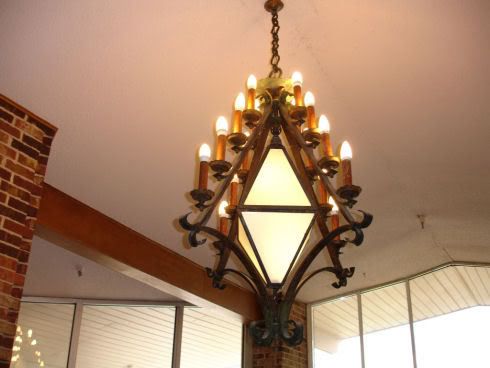
The Liberty/Harber/Cooper Cinerama and The State. These theaters were in the 100 block of North Robinson and faced each other, the Harber on the west and the State on the east, as shown in the images below.
Around 1937, after the State was constructed
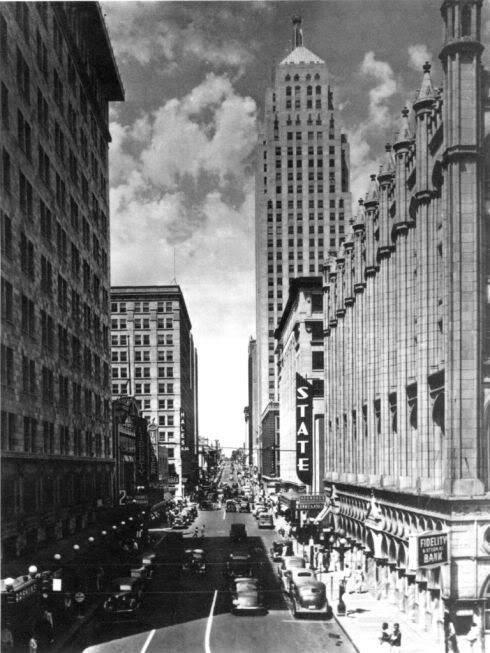
A cropped view of the above pic
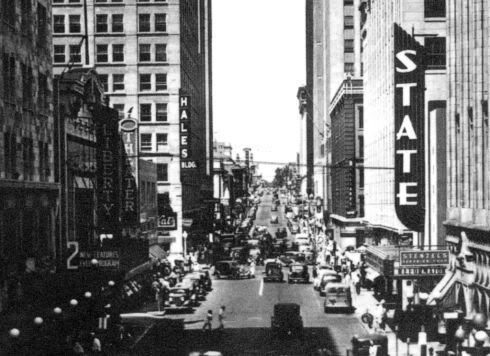
Same general view from Vanished Splendor III in 1953
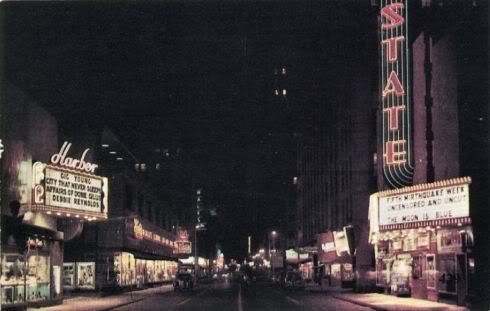
From Oklahoma City: 2nd Time Around
Around 1966 (The Spy Who Came In From The Cold
was released in December 1965)
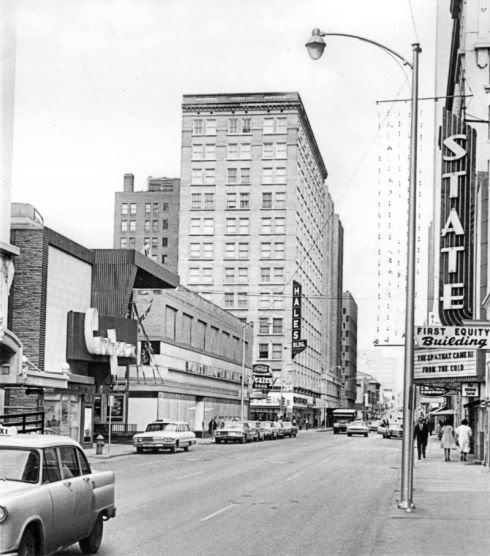
The Liberty/Harber/Cooper. The theater on the left, above, was originally the Liberty, built in 1915. It eventually became the Harber, and, finally, the Cooper Cinerama in 1960, seating 1,200. It closed in 1975.
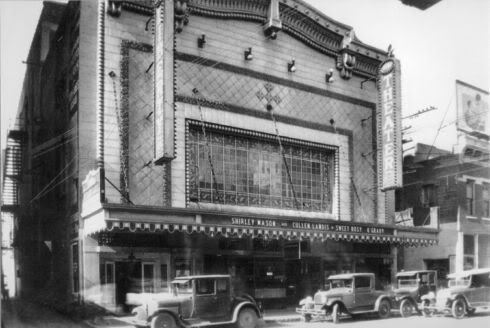
From Historical Photos of Oklahoma City around 1928
The oil derrick still sits atop the Petroleum Building
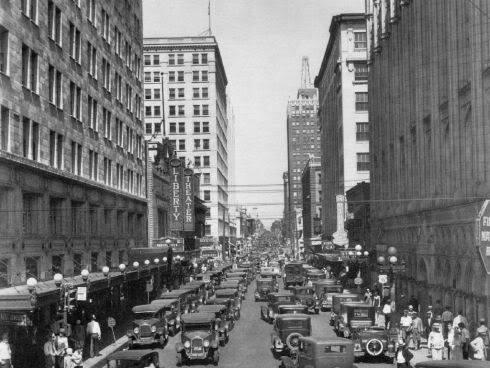
In 1953 (crop from the Vanished Splendor III pic, above)
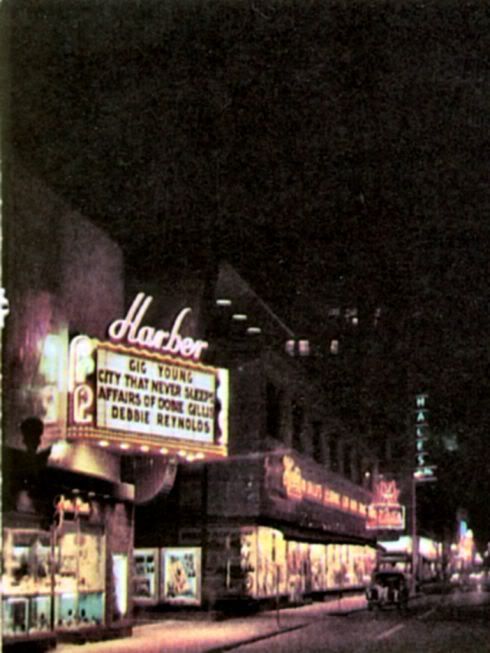
From Jeff Chapman's Liberty Theater Collection in the 1960s
(Larger image not available)
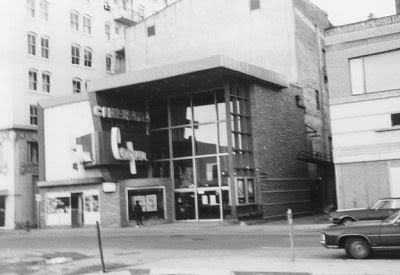
The State. The State opened on March 5, 1937, as shown by the Oklahoman article below. A Columbia movie house, its first movie was When You're In Love with 1st billing to Grace Moore, 2nd to Cary Grant.
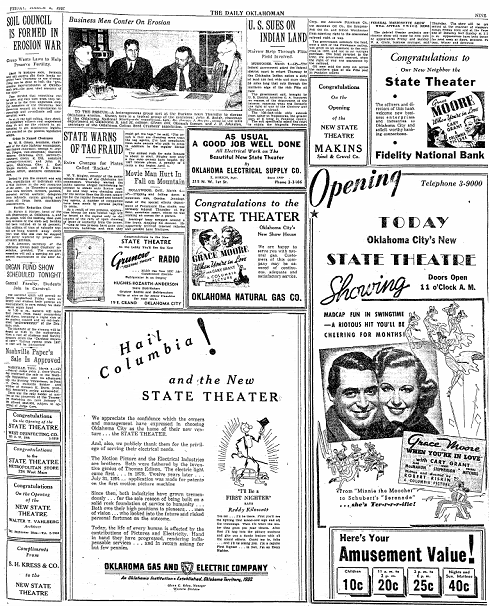
According to internet sources, it seated 1,100 to 800 (reports vary). As said above, it was initially a Columbia movie house but the historical references I've found are pretty sketchy so I don't know if linkage lasted until the State closed in 1970 and was demolished in 1971 during urban renewal (see below). Aside from a couple of postcards along Robinson (already shown which really serve no purpose other than to show the theater's location), the only half-way decent image I've found while the State was alive is the same image from Vanished Splendor III, cropped below to show the State on the east side of Robinson.
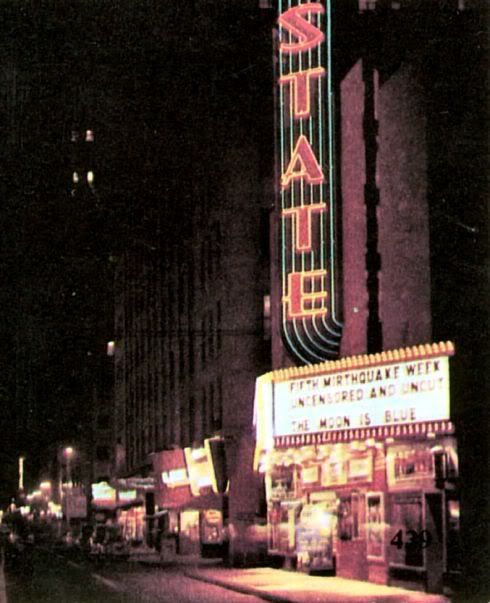
Sadly, the best image of the State's entry I've found when it was being demolished in 1971 as part of the massive urban renewal downtown destruction.
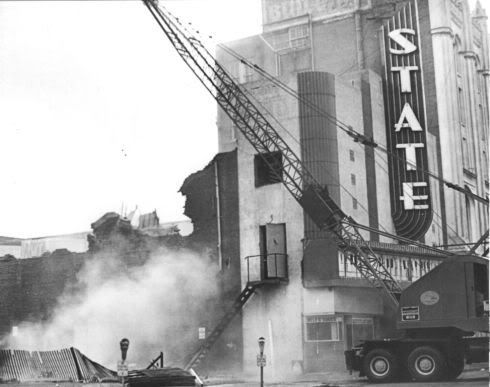
The Centre. The 1,600 seat Centre Theater designed by the Kansas City Boller Brothers firm was built in 1947. Eventually, after it closed (reports vary as to date, mid to late 1970's), it became the kernel for the Oklahoma City Museum of Art (but as part of a much larger structure) and a small nicely done stadium style theater (called the Noble Theater ... see click here for detail ... is present in the complex. That latter-day theater screens independent, foreign language, and classic films on Thursdays through Sundays. For movies about to be shown, click here. I've not found any particularly good images of the Centre so far. But, see Jeff Chapman's Noble Theater Collection at CinemaTours for some interior and exterior views near or at the theater's end.
An artist's rendering in the Oklahoman (with the theater's name misspelled) and a couple of cropped-together smaller images appear below. Larger images are not available.
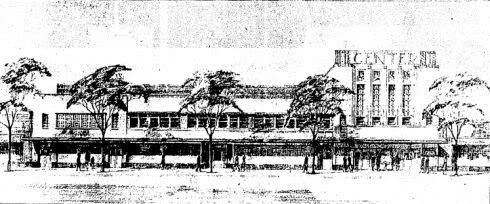
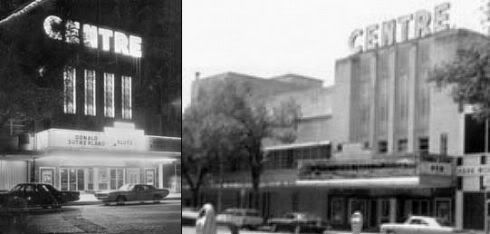
Older Downtown Theaters. While the above are the theaters most of us old enough often remember, others existed downtown well before almost all of us were born. In more or less chronological order, most of those early-day theaters are shown below.
Folly. The Folly opened in 1908, two buildings east of where the Baum building would be built in 1910 on Grand (Sheridan). The September 20, 1908, Oklahoman article gives a description:
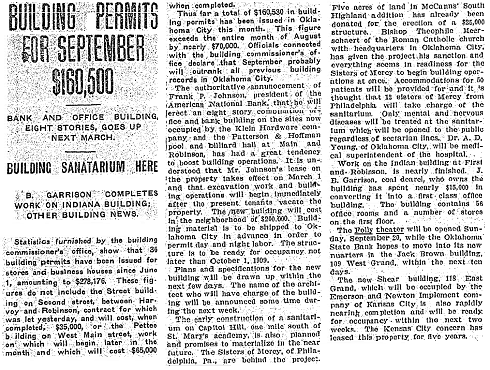
Credit Vanished Splendor (I) by Jim Edwards and Hal Ottaway
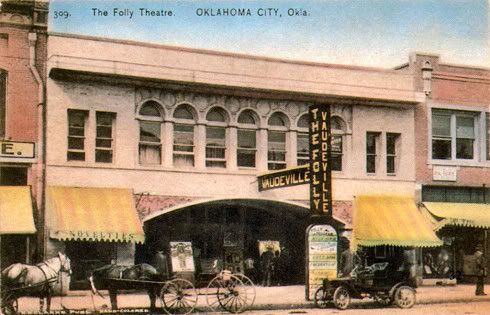
In the 1940s
Credit Whistlestop Trains/Vintage Rail Photos
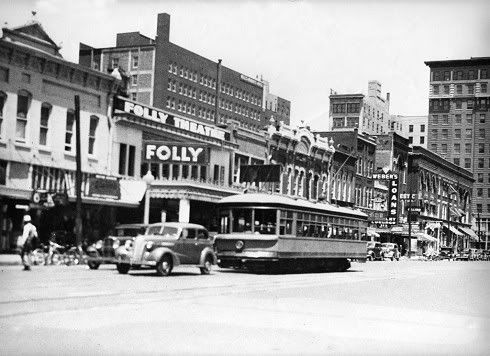
Additional images of the Folly are shown in the Majestic Theater photos, below.
Metropolitan. This theater opened in 1909 at 320-322 W. Main, south of the Terminal Building (Oklahoma Railway Company's building and trolley terminal).
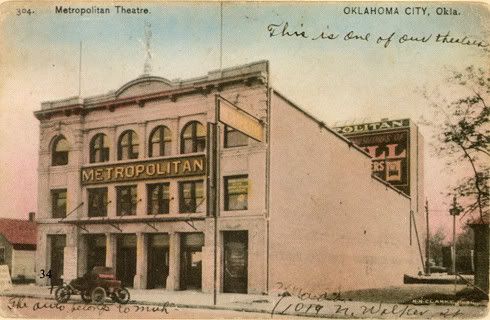
The theater had its own stock company but also engaged early day notable companies like the North Brothers Stock Company. But, in 1917, it became the Palace Theater, as shown below:
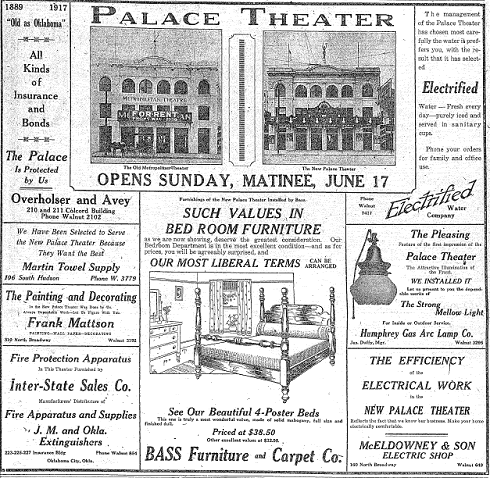
A September 18, 1921, Oklahoman Ad
(larger image not available)
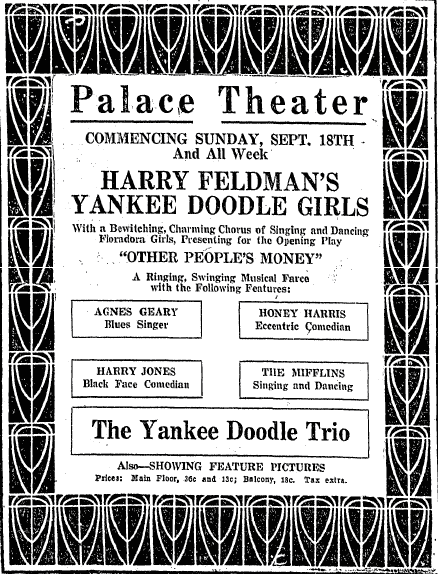
The theater received damage when dynamited in 1929, perhaps arising out of a union shop agreement with other city theaters to which the Palace would not give its assent. A July 7, 1929, Oklahoman article reported as follows:
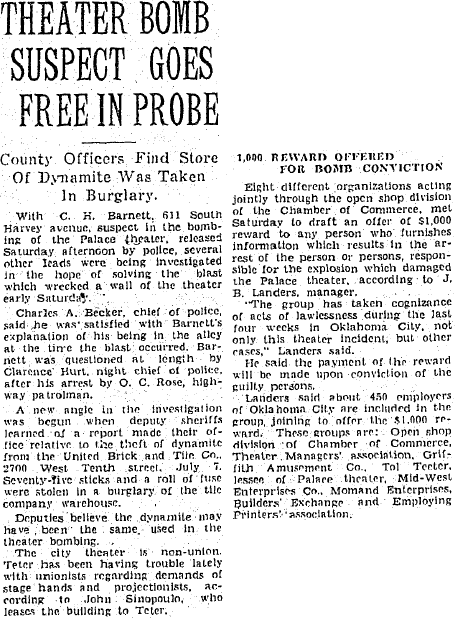
About the theater, Vanished Splendor (I) says,
The theater opened in January 1909. One of the early day stage hands was Lon Cheny, who went on from Oklahoma City to leave his mark on the world stage. Labor problems surfaced in 1929 because the Metropolitan was the only non-union theater in town, and in July of that year the structure was badly damaged when it was dynamited. It was condemned and torn down in 1935 as part of the WPA job program in the city.Articles in July 1935 Oklahoman issues confirm that.
After the dynamiting and before its destruction, at least some movie fare at the Palace had become "adults only" as is shown below - larger images are not available for the next two ads:
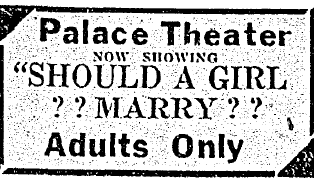
March 22, 1931 - also see the Rialto, below
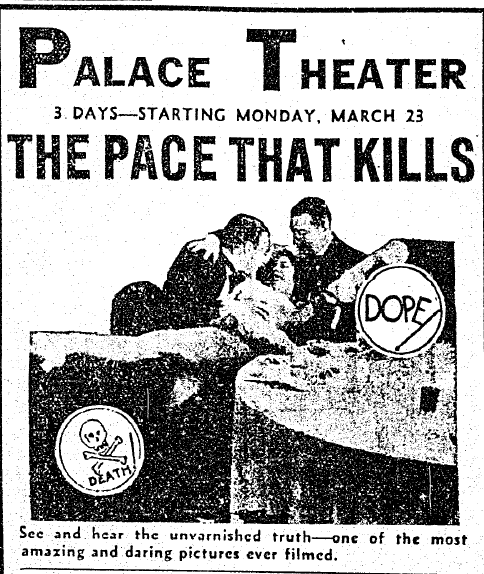
The Dreamland (later the Capitol). The earliest version of the Dreamland was around 1907 in a different location. The one which became a downtown fixture, though, opened in September 1911 at 308 W. Main, two buildings west of the Mellon Department Store. In 1920, it was remodeled and became the Capitol Theater.
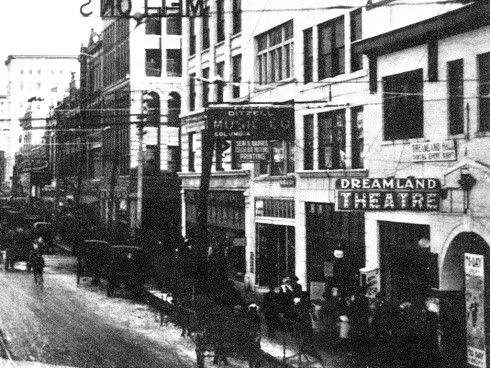
In the 1920s as the Capitol Theater
Credit Whistlestop Trains/Vintage Rail Photos
In the foreground, this photo shows the elegant Mercantile Building and
further away the ornate Patterson Building as Oklahoma Railway Company trolleys exit the downtown terminal
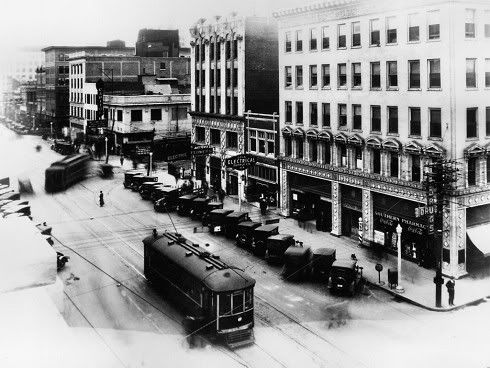
Crop of the above focusing on the Capitol Theater
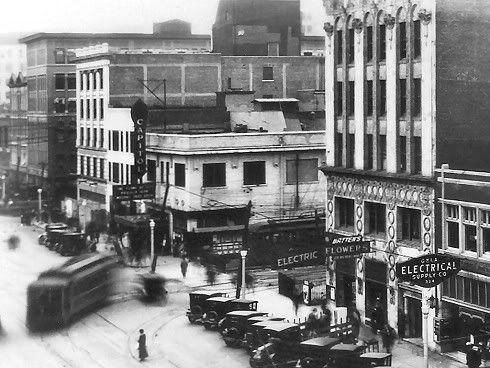
The Empress. This theater was located at 111-113 W. Main (north and across street from the Criterion) and it opened in 1911 as shown by the November 26, 1911 and December 4, 1911, Oklahoman articles below.
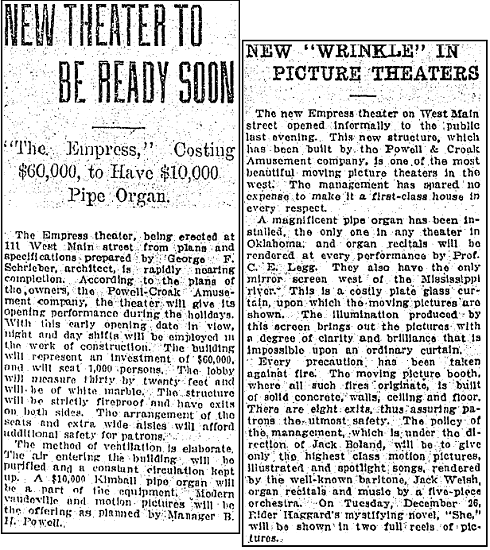
From Vanished Splendor III around 1923
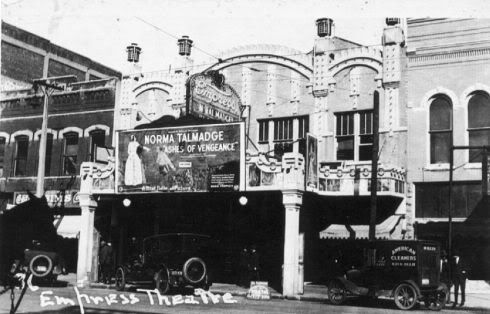
From Historic Photos of Oklahoma City in 1926

The Majestic. Opening in 1911 along with the Empress, the Majestic was located at 111 W. Grand, two buildings east of the Baum.
Both the Folly and the Majestic are shown on Grand Avenue, looking west, courtesy of Ms. Elaine Schuster, below. I was unable to avoid glare/reflection from the glass when taking the photo, but it's still a great photograph.
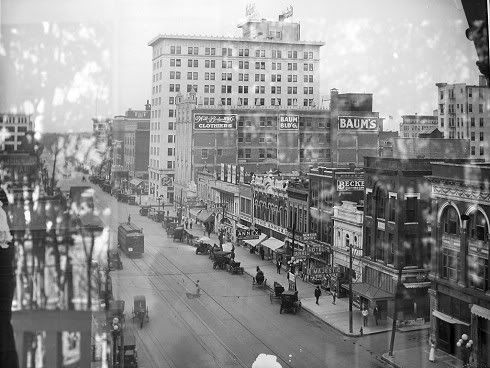
Narrowing the view

Focusing on the Folly and Majestic Theaters
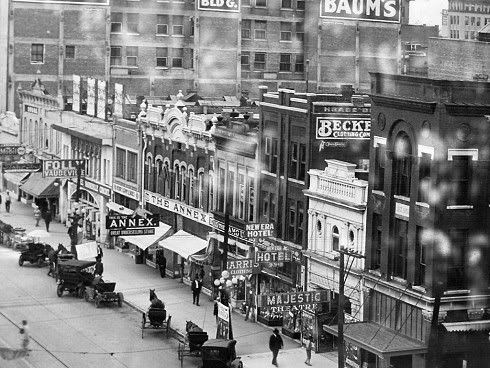
The Rialto opened in April 1921, immediately east of the Baum Building at 131 W. Grand (Sheridan).
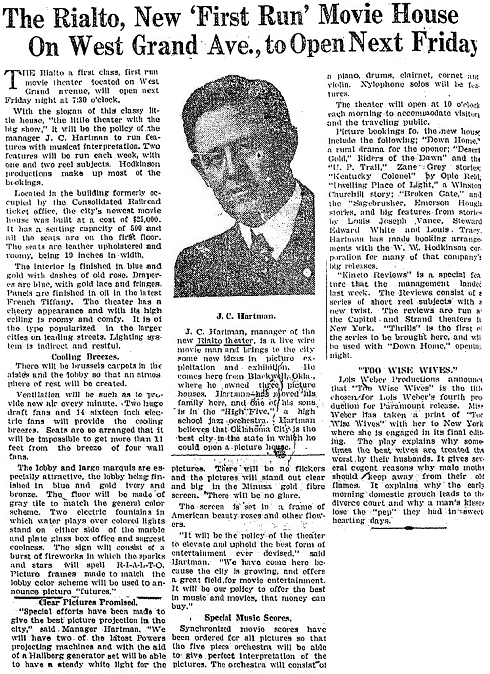
Despite its "first class" origins, by the mid-1930s, that had apparently changed, if the adults only movie, The Pace That Kills, provides an indication - see the last Palace ad, above. Though the movie was not described as particularly uplifting, it drew a good crowd on this day!
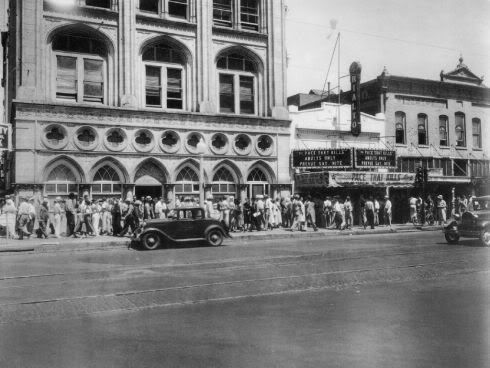
Zooming In ...
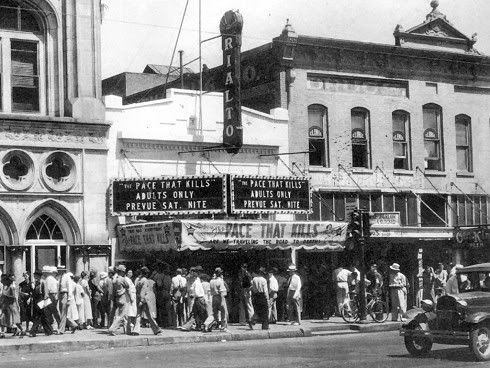
Others - the Lyric & the Isis. These two other downtown theaters shown in various Oklahoman ads during this period. I've not located a photo for the Lyric. The Lyric was described in the following Oklahoman ads as being at the corner of Grand (Sheridan) and Harvey - larger images for the next two pics are not available.

May 4, 1916, ad
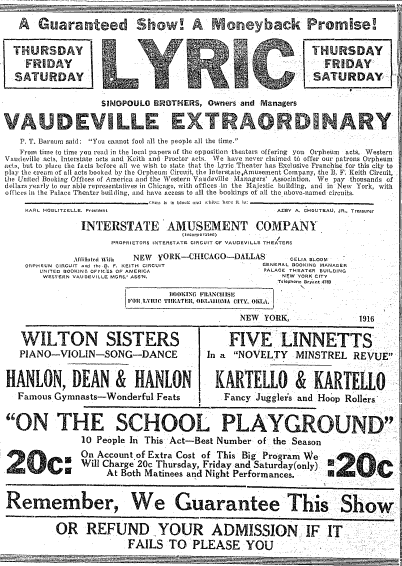
Whether the Lyric played movies, I don't know. It apparently moved at some point to Robinson since a September 1, 1930, Oklahoman article said, "The old Lyric theater was torn down to make way a few years ago for the 12-story Perrine building." The Perrine, now Robinson Renaissance, was built at the southwest corner of Robinson & NW 1st (Park Avenue) in 1927. The Isis was located at 121 W. Reno and existed by September 1921. It apparently ran only "B" or "second-run" movies and perhaps some light porn during its existence -- the last mention that I could locate in the Oklahoman was on January 15, 1947, describing its ownership (Griffith Theaters) and management. I could not find any Isis "ads" after the early 1930s. An Oklahoma Historical Society image shows the frontage and a not-very-good image from the September 11, 1933, Oklahoman shows the building, being next door to another building being attended to by Oklahoma City firemen, both below. Some unsubstantiated discussion about the Isis is at the Cinema Treasures website.
(according to this website, Dance Hall Hostess was a 1933 movie,
and this website shows Tracy Rides as a 1935 movie)
(larger image not available)
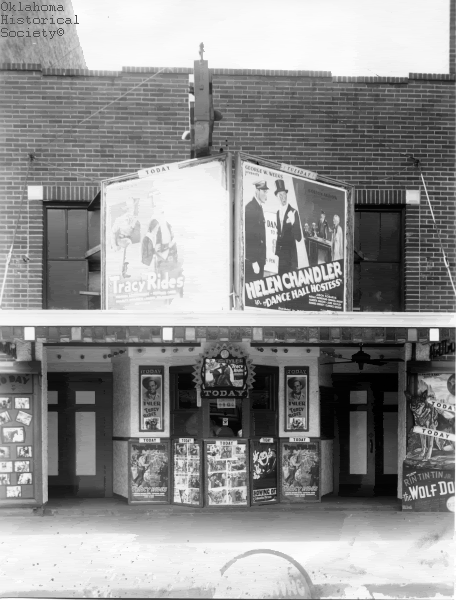
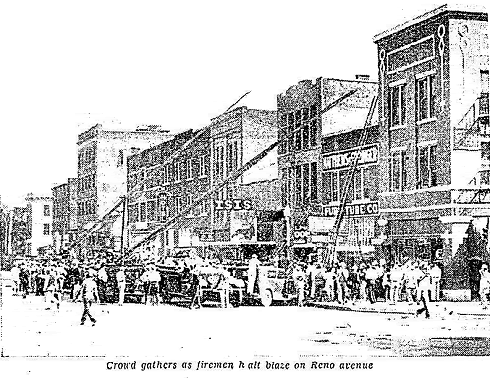
There are others and I'll be adding them shortly, e.g., the Broadway/Capital, Home State, Gem, Bijou, Reno, Pix, Gaiety, and Strand/Olympic. The Oklahoman's ads do mention other theater names, but they were not located downtown such as the 1928 Ritz (1020 E. 13th - NE 13th & Stonewall), the 1928 Victoria (northwest corner of Classen & NW 18th), the late 1920's Circle (2510 S. Robinson), and the 1919 Aldridge in Deep Deuce at 303-305 N.E. 2nd.
1920s Advertisements. O.K., let's say you are about 100 to 90 years old as this article is written in 2008. What movies would you typically see if you went downtown to the movies in the early 1920s? They weren't "talkies" yet and all was black and white on a small square screen, and they "fickered," but it is evident that such movies without speech were as popular as the color high resolution wide-screen sometimes computer generated with great sound movies are today. A couple of examples are shown below.
(click the image for a readable high resolution view)
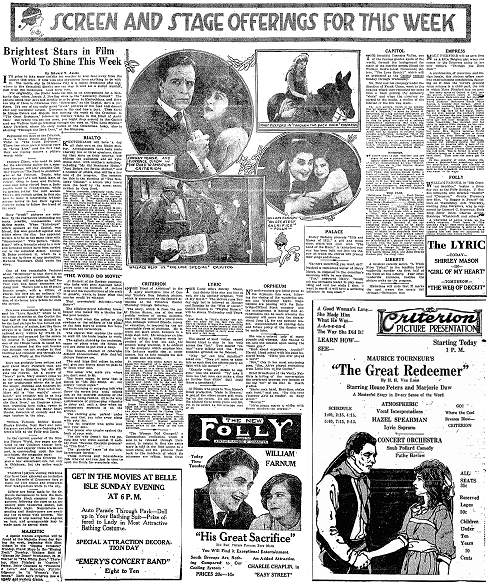
Ads on the page following the above
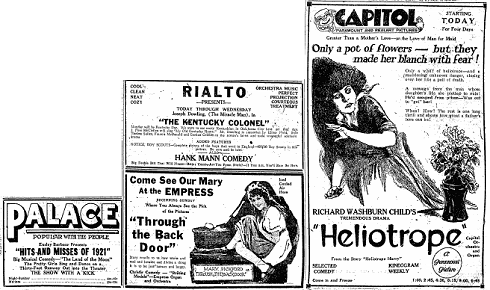
I'll give more detail from the following November 2, 1924, Oklahoman article . . .
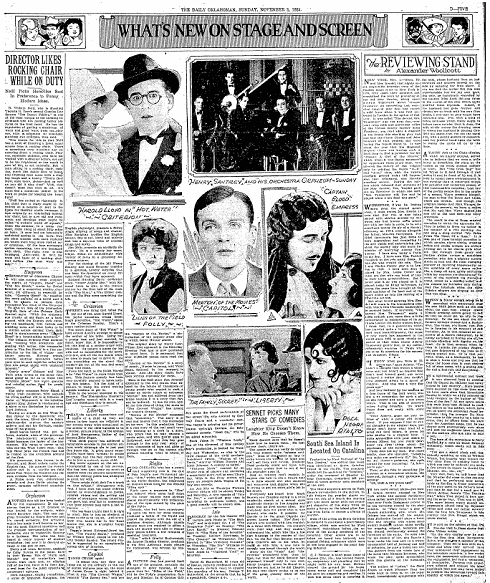
Here's the detail
At the Rialto & Folly
(Larger image not available
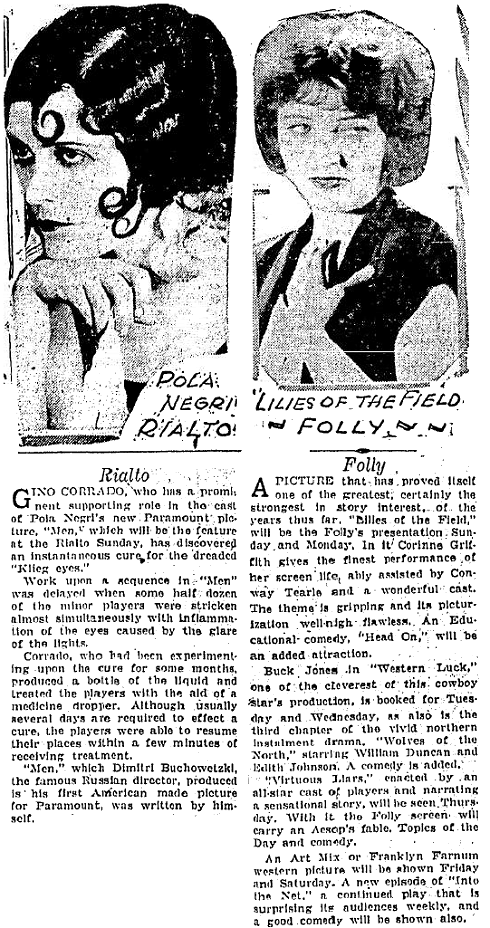
At the Empress and Isis (to be described later)
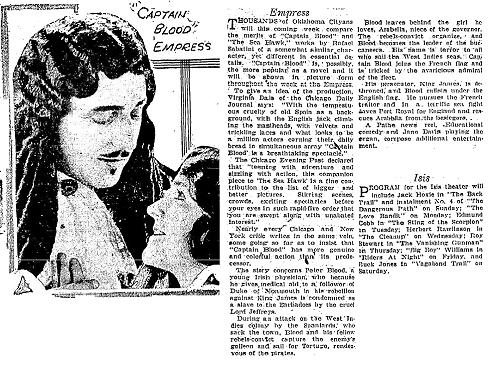
At the Criterion
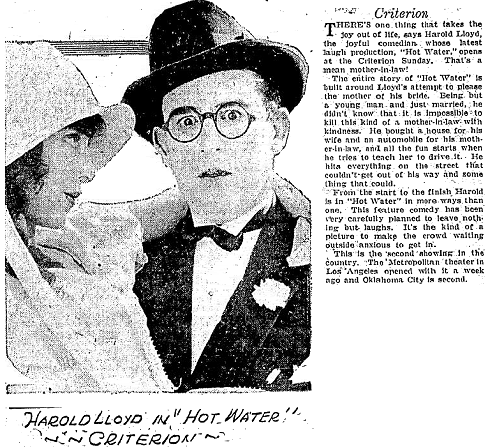
At the Liberty
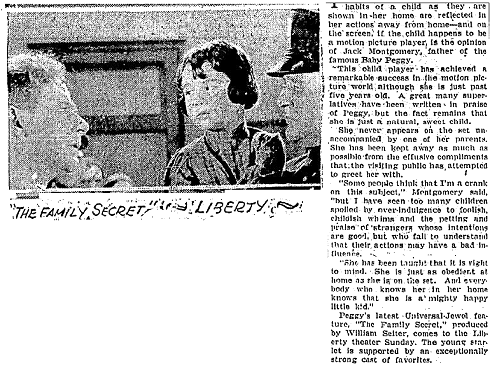
At the Capitol
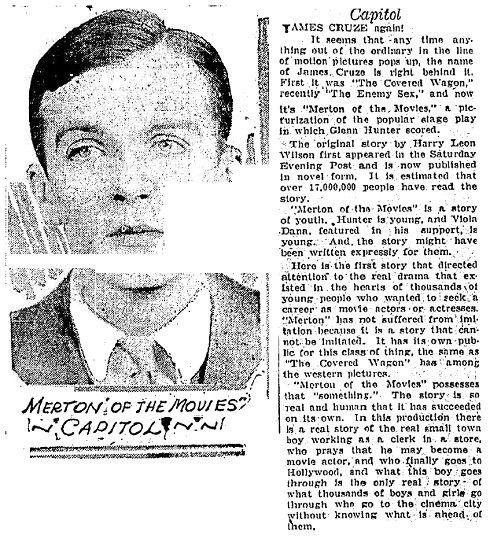
At the Orpheium
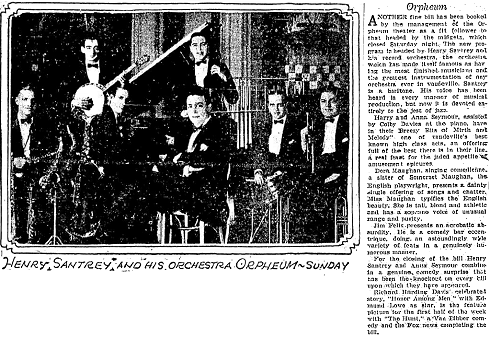
Movies On My Birtdhday. O.K. What if you were a young guy like me, born in 1943! Ever diligent in searching for clues that might help explain certain elements of my personality, since I was born at St. Anthonys in early July 1943, I thought that Oklahoman ads as to what was playing downtown might give some insight! And, indeed, they did! Here's what I found — instant karma!

In any event, all of the above theaters were either closed or destroyed at least by the mid-1970's — I can't yet identify which theater was, "The Last Picture Show," but it doesn't matter — there was no place downtown to go.
Harkins Cinema & Cine Capri. After the last of downtown's grand or not-so-grand movie houses closed, it would not be until 2004, about 30 years later, that one could say, "Let's go downtown to the movies!" and have any place to go. Enter Harkins Cinema & Cine Capri on October 1, 2004, with the opening of the Harkins Cinema & Cine Capri at 150 E. Reno in Bricktown. Hosting 16 screens, including Cine Capri (with a 70-foot wide screen, 600 seats, 144 speakers and 40,000 watts of power and pure digital sound, the Cine Capri is the largest cinema screen in Oklahoma City — it even has stage curtains and curtains against the walls, for god's sake) — and located in an area that old-time-downtown-movie-goers would never have dreamed possible, that run-down area which was once called, "the warehouse district," in its best day which by the 1960s were well within the rearview mirror.
Though a long time coming, patience paid off — this element of Bricktown had been promised to occur 8 years earlier than it did — the Harkins Cinema & Cine Capri has become a great downtown destination. They've even got a child care facility not to mention the other nearby things to do – a walk on the canal, Bricktown entertainment and dining, and the nearby Oklahoma Land Run Monument (saluting the Land Run of 1889 that saw the birth of Oklahoma City which will feature 46 "heroic-size" bronze pieces and will stretch more than 300 feet – it's just south and west a few hundred yards away from the theater). On one occasion, coming out of the theater around 10 pm, a mime who looked remarkably like a bronzed Will Rogers was seen entertaining the kids and wooing the women by the Centennial Fountain which is just north of the Harkins.
The Harkins is a family owned corporation headquartered in Phoenix and I'm mighty glad that it chose Oklahoma City as its first venture beyond the borders of the Grand Canyon State! See http://www.harkinstheatres.com/redharkins.asp and http://www.harkinstheatres.com/danharkins.asp for the history of this fine organization. They've proven to be good local citizens, too, most recently being one of the hosts and sponsors of Oklahoma City's 6th Annual deadCENTER Film Festival, June 7-11, 2006. See http://www.deadcenterfilm.org/venueandpress06.html.
Except for the last, I took the images below on September 24, 2007, in the mid-afternoon when not much was going on.
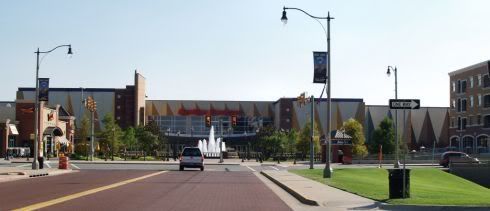
The Centennial Fountain Lies Immediately North of the Harkins
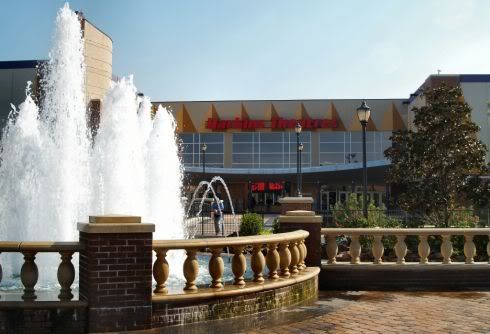
As Does the Bricktown Canal
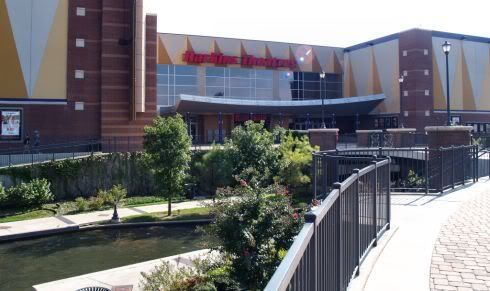
In Front of the Harkins Looking Southeasterly
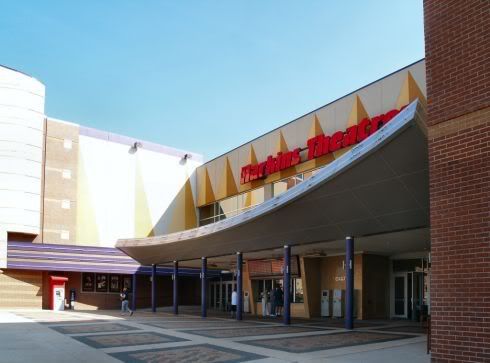
Walking North Toward the Centennial Fountain
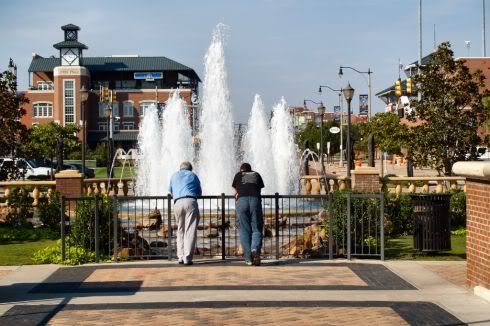
Looking Northwest From the Centennial Fountain

Zooming In Toward Downtown
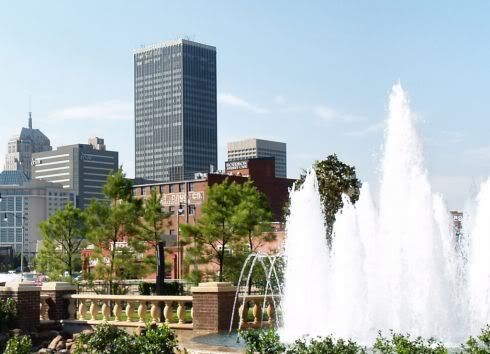
On a Hot August Night, August 2006
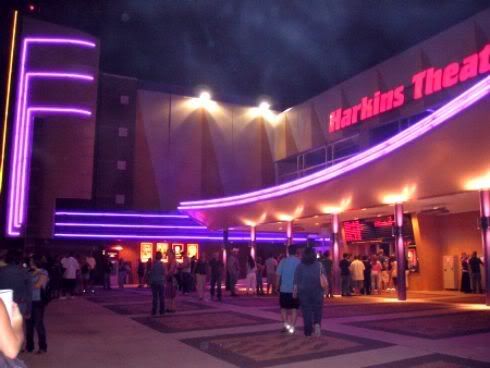
On September 26, 2007
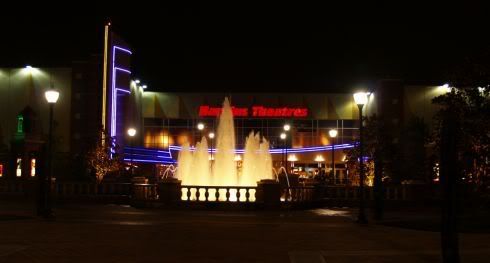
So, once again, we can say, "Hey, let's go downtown to the movies!" and have a great place to go!














22 comments:
I love to remember the old downtown theaters. My father's office was upstairs in the Midwest building and I would catch a movie downstairs while Dad worked!
Trivia: The 1973 movie DILLINGER (a film finally being seen as the classic gangster movie that it is) was filmed in Oklahoma; much of it in Oklahoma City. All restaurant (Skirvin) and city street scenes were filmed in OKC, as was the shooting of Dillinger. The Midwest Theater was transformed into Chicago's Biograph for the fateful Purvis-Dillinger meeting in the alley.
Great trivia, writerranger!
So, how many balconies was it, 4, 5? I'm only remembering that it had that many, but it may just be a fanciful memory!
Can you comment on the Warner (since I was never there)?
The Midwest was long and narrow with a lengthy lobby. It had only one balcony, but it went up and up. Perhaps you count balconies by the transvese aisles. Even so, I don't remember more than one. The main floor had a central aisle, an oddity, losing exact center seats. The Criterion was wide with steeply raked seats down-
stairs. The balcony, of course, was raked and in my memory larger than the main floor. There was an additional entrance exit stairway half way up the balcony on the west side. Can't remember about east side.
Thanks, John, but "hmmmmm..." Of course, it's entirely possible that my memories from child's (teenager's) eyes may have got it wrong but I'll see if I can find something more authoritative somewhere about this.
Great article. Well written! Cheers and Kudos!
Notice that Symco states at CinemaTreasures.org that he has blueprints of the Midwest.
Symco's comment was found again only by retracing a search profile. The URL is http://cinematreasures.org/theater/17149.
Symco has two or more comments on Feb. 11, 2007.
WOW! What memories!
I remember the Copper, where I saw "Krakatoa:East of Java" first run. The last film I saw there was "Last House On The Left" :(
The Midwest was beautiful. I saw "In Harm's Way" there, and marvelled at the "stars" in the deep blue ceiling.
The Centre where, as a child, I saw "Mary Poppins" and "The Thomas Crown Afair". And so many more. What a shame that these old theaters were razed to put up newer, but not necessarily better buildings. OKC lost much of it's charm when Urban Renewal took hold. In 7th grade, I went to old Central Jr/Sr HS, and after class, I would wander downtown until it was time to meet up with Mom and ride home with her.
Veazey's was always a great place to hang out, or hitting the toy department of John A. Browns. Haunting the pawn and surplus stores was always a great adventure, too. I miss the "old" OKC. Urban Renewal took a lot away from us, and to me, didn't give nearly as much back.
Robert Conner
Pryor, OK
The Midwest had a lower and upper balcony. The lower area was the loge and was a higher priced seating area than the upper balcony when tickets were on reserved seating. There was a central entry point that had two different isles that led to each side of the balcony. The ceiling of the theatre had a blue sky, clouds and stars with the the big and little dipper in lites.
yriuryujry
The first time I went into the new Warren Theater in Moore I welled up with tears. I couldn't believe anyone would ever build a movie palace again in my lifetime. Its all there with every appointment you could ever imagine. I then read on his web page that he even abandoned a plan to be the biggest theater in the USA just to make it the best ever built in modern times. I believe he has arrived. The one thing it could still use is a big pipe organ in one of the big rooms. Maybe that's a pipe dream, as it were. One of our historic pipe organs is in need of major repairs. The Kilgen 4/16 that was part of WKY radio in the Skirvin is now in the Oklahoma History Center. It needs lots of work though. Its not fully installed. Its former location was in the Civic Center but they thought it was too small and the Civic Center artistic director didn't like organs anyway. I hope it can be fixed and back up and running some day.
Re the "Center theater's name" being misspelled an the original architectural drawing above, not so! The Center was opened and operated as "The Center Theater" until a remodel in the late 1960s or early 1970s. Somebody decided to switch the "R" and the "E". "Centre" was (to them) more sophisticated perhaps that the original "Center". OPUBCO records probaly have an article about this. Not only did I read that, I also saw it happen; was down there when the crane did the deed. - Scott Foster, Honolulu (age 70)
Were the blacklite Art Moderne murals inside the Center Theater preserved with the recent art center remodel/conversion? Or are there any photos? It was pure magic to sit there in the dark and view them; ballet dancers, a long, curving music staff, mummers masks, a soaring Pegasus (flyig horse), musical instruments floating in the dark, and numerous other mystical images representing the arts and the magic of movies. I would sell my bets friend for photos of those murals.
Scott
A few months ago I was in OKC and met a friend for breakfast at the
restaurant adjoining the ole Center
Theater and out of curiosity, I strolled into the lobby and was amazed to see the original curved stairway going up to the balcony.
But, that was the only thing that I saw that was original. The lower level lounge gone, however, the original box office was still in use. Pretty incredible!
I recall seeing the first showing at the Center of James Bond Dr. No
at a Friday nite sneak preview and went on to see the next few Bond Movies also at the Center as well as many, many other great flix.
Several photo's of the ole Centre Theatre can be found on the CinemaTour Web Site as well as some current photo's. Here's the link...http://www.cinematour.com/tour/us/12307.html
Thanks, LongestDay. Here's a working link to what you posted: http://www.cinematour.com/tour/us/12307.html.
To correct one small detail. Your comments always refer to the later years of the Cooper Theater as the "Cooper Cinerama" but it was never called that. The sign, if you could read it all, actually read: at the top, Home of Cinerama, and the word Cooper below, but the actual name was just "Cooper".
I'm 72 and I saw all of the first-run feature films of the late-1940s, 1950s & 60s in one of the downtown OKC theaters you memorialize here. Thanks for the memories.
P.S. I would give anything to see photos of the two blacklite murals in the Center/Centre Theater. Talk about Deco Modern! I've not been inside since the museum was so wisely created and can only hope those murals survived.
Regarding the blacklite murals..I do not recall seeing them on my last visit to the Centre/Museum. Where were they located in the Theatre?
Another comment on the Midwest. When it was used to portray the Biograph Theater in Chicago, back in 1973 by American International. Their prop men hung a sign over the MIDWEST lettering at the top of the marquee, which read Biograph... Under the marquee, in similar fashion to the original Biograph in Chicago, where Dillinger was gunned down in JULY, on a sultry night. They hung a large banner, that read Cooled BY Refrigeration....On the November night that they filmed, it was around 30 degrees, all of the actors and extras were in overcoats, visible exhaust vapor emitted from the exhausts of the Model A Fords tooling up and down Harvey at my direction via walkie talkies in the cars. I mentioned to the director, that it would look pretty silly to have that sign reading Cooled by Refrigeration, on such an obvious cold night. Hurriedly, they removed the sign. I have a photo showing it. There was also a night club scene in the film, which was made in the Skirvin Tower Club, across the street west from the Skirvin Hotel. In the basement of the Skirvin Tower. Dillinger, which had a one million dollar budget, ought to be recognized as one of the great Oklahoma films. Which was filmed in it's entirety in Oklahoma. making use of much Oklahoma talent in the film as well. Was a lot of fun working on that film in the fall of 1973.
Steve, thanks for that great comment!
The photo of the Isis Theater "Crowd gathers as firemen halt blaze on Reno avenue" is not in the Septemebr 11, 1933, edition of the Daily Oklahoman newspaper. Any idea what the actual date of the photo is or what edition it's in?
Post a Comment